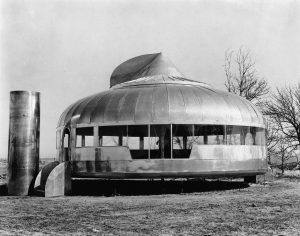The shortage of affordable housing after World War II re-sparked Buckminster’s initial goal to develop mass-produced residential housing. Working for the Foreign Economic Administration in Washington D.C. during the war, he was able to hone in on new ideas and redevelop the failed 4D house. In 1944, with the end of the war in sight, Fuller made a deal with the Beech Aircraft Corporation in Wichita, Kansas to produce his reconstructed Dymaxion House. Beech had played an important role during WWII producing aircraft bombers at their midwestern factory, but the end of the war meant uncertainty for the future of the company. With a surplus of aluminum on their hands and workers to employ, under Fuller’s guidance, the company hoped to produce up to 50,000 Dymaxion homes annually.[2] Prior to the end of construction of the prototype, Beech released a full-length article on “The Fuller House” in its official bulletin The Beech Log describing the house in detail. [1] In 1945 two physical prototypes, one indoor and one outdoor, were officially unveiled. The new house was aptly titled the Dymaxion Dwelling Machine. A Fortune magazine feature on the house published in 1946 was titled “Fuller’s House: It Has a Better Than Even Chance of Upsetting the Building Industry.”
Fuller’s new design, the Dymaxion Dwelling Machine, popularly known as the Wichita House, was round instead of hexagonal. Like the 4D Dymaxion, the center mast of the Dwelling Machine was mounted on top of a sunken concrete post and the remainder of the house was stacked around it. Unlike the 4D house, the Dymaxion Dwelling Machine would not face the issues that had caused its predecessor to fail. New innovations as a result of the war brought Buckminster the technology needed to make the house a success, namely materials. These included new corrosion-resistant aluminum alloys, plastic ‘Plexi-Glass’ windows, steel, plywood, and synthetic rubber.
One of the key components of the Wichita House prototype was its transportability. Each Dymaxion Dwelling Machine could be packed within a 16 x-4 1/2 foot shipping tube, the type designed to fit aircraft parts, and shipped anywhere. [5] Unpacked, the house could be constructed in less than a day. The complete structure was primarily made of stamped aluminum and aluminum alloy, weighed three tons, and measured 36 feet in diameter (approximately 1,017 sq. feet). The interior of the house featured a “living room-dining room, two bedrooms, two Dymaxion bathrooms, and a kitchen equipped with an electric refrigerator, deep-freeze storage unit, range, washing machine sink, laundry bin, and waste disposal unit. ” [3] Other interior features included the Ovolving shelves that Fuller had installed in the 1929 Dymaxion House. The floors consisted of layers of netting sandwiched between pneumatic rubber covered with faux leather at the surface. Interestingly the built-in furniture was not included. To the displeasure of Fuller who wanted pneumatic furniture, Beech officials insisted on furnishing the house with traditional middle-class furniture to appeal to prospective buyers and overcompensate for the unusual exterior of the house. [6] The main difference Buckminster espoused between the standard post-war brick and mortar home and his home was the cost. Keeping his promise to maintain affordability, the Dymaxion Dwelling Machine could be purchased for a total cost of $6, 500, or the price of a Cadillac.
After much promotion by Beech, visitors flocked to Wichita to see the house. Over 3,500 orders were placed by customers wishing to purchase the house of the future and the success of the project seemed imminent. Buckminster didn’t think the infrastructure to set up distribution of the houses was ready and insisted on seven more years to work through some of the issues he saw with the prototype. Licensed electricians and plumbers also refused to set up service for the houses as the majority of pre-installation had been completed by machinists outside of their unions. [4]
Investors in the project grew impatient and Beech was unable to come up with the amount of money required to go into full-scale production of the houses. The project eventually collapsed when Fuller walked away from it leaving only the two prototypes as the result of his vision. In 1948, an investor named William Graham purchased the two Dymaxion Dwelling Machine prototypes. He utilized portions of both houses and moved his family into the structure. The Grahams resided in the Dymaxion home as their primary residence until the 1970s. The house was abandoned until 1990 when the Graham family donated it to the Henry Ford Museum. After arriving at Henry Ford, the structure was completely renovated and has been on permanent display at the museum since 2001.
By: Tara Seaver
[1] Frederico Neder, Fuller Houses: R. Buckminster Fuller’s Dymaxion Dwellings and Other Dymaxion Adventures (Zurich: Lars Muller, 2008), 61.
[2] Michael J. Auer, “The Dymaxion Dwelling Machine”, in Yesterday’s Houses of Tomorrow, ed. H. Ward Jandl (Washington D.C.: The Preservation Press, 1991), 92.
[3] Michael J. Auer, “The Dymaxion Dwelling Machine”, in Yesterday’s Houses of Tomorrow, ed. H. Ward Jandl (Washington D.C.: The Preservation Press, 1991), 92.
[4] J. Baldwin, BuckyWorks: Buckminster Fuller’s Ideas for Today (New York: John Wiley & Sons, Inc., 1966), 52.
[5] Michael John Gorman, Buckminster Fuller: Designing for Mobility, (Milan: Skira, 2005), 70.
[6] Michael J. Auer, “The Dymaxion Dwelling Machine”, in Yesterday’s Houses of Tomorrow, ed. H. Ward Jandl (Washington D.C.: The Preservation Press, 1991), 95.


